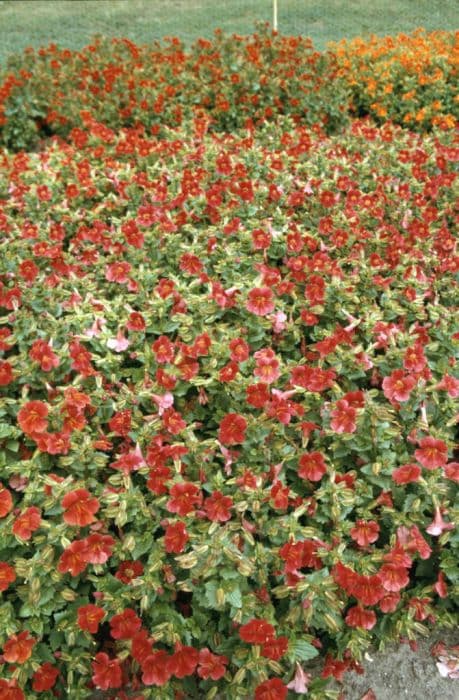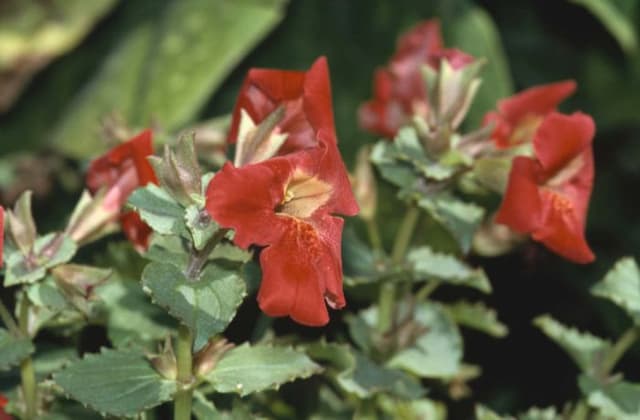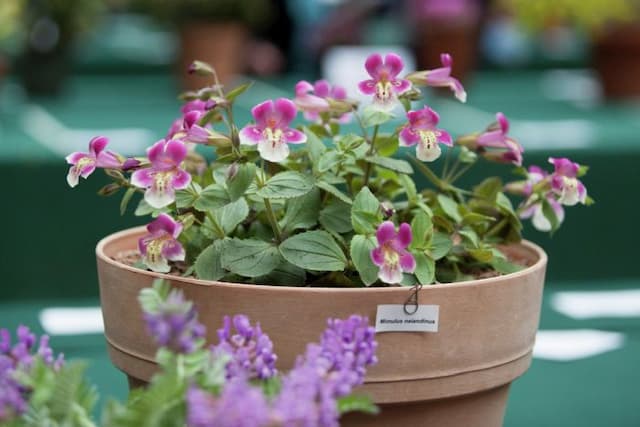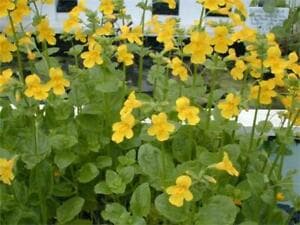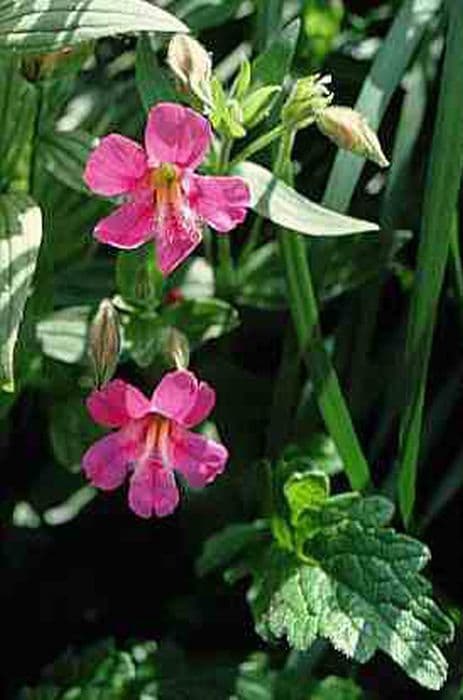Scarlet Monkeyflower Mimulus cardinalis

ABOUT
Mimulus cardinalis, commonly known as scarlet monkeyflower, is an eye-catching perennial plant. It has bright green, toothed, and ovate leaves creating a lush backdrop for its unique and vivid blossoms. The most notable characteristics of the scarlet monkeyflower are its striking tubular flowers which are a fiery scarlet or red-orange in color, providing a stark contrast to the foliage. Each flower is bilateral-symmetrical, resembling a face, from which the common name 'monkeyflower' is derived. The blooms typically have two lips; the upper lip is usually composed of two lobes, while the lower lip features three. The interior of the flower often has attractive patterns and spots, which serve to guide pollinators to the nectar within. These blooms can be seen forming in small clusters. The plant's stems are somewhat square in shape and can have either a green or reddish tint to them, depending on exposure to sunlight and other growing conditions. In sum, the scarlet monkeyflower is a striking plant, renowned for its vibrant flowers that add a splash of color to the environments where it grows.
About this plant
 Names
NamesFamily
Phrymaceae.
Synonyms
Scarlet Monkeyflower, Red Monkeyflower.
Common names
Diplacus cardinalis, Eunanus cardinalis, Mimulus coccineus, Mimulus fulgens, Mimulus langsdorffii var. cardinalis, Mimulus lewisii var. cardinalis, Mimulus luteus var. cardinalis.
 Toxicity
ToxicityTo humans
Scarlet Monkeyflower is generally not considered toxic to humans. There are no well-documented cases of poisoning from consuming parts of this plant. As with any plant, individual allergies or sensitivities can exist, and ingesting plant parts is not advisable without proper knowledge of their edibility and safety.
To pets
Scarlet Monkeyflower is not known to be toxic to pets. However, it's always best to prevent pets from ingesting plants as they may cause gastrointestinal upset or an allergic reaction in some animals. If your pet has ingested parts of this plant and is showing symptoms of distress, it is wise to consult a veterinarian.
 Characteristics
CharacteristicsLife cycle
Perennials
Foliage type
Deciduous
Color of leaves
Green
Flower color
Red
Height
3 feet (0.91 meters)
Spread
2 feet (0.61 meters)
Plant type
Herb
Hardiness zones
9
Native area
North America
Benefits
 General Benefits
General Benefits- Attracts Pollinators: Mimulus cardinalis, commonly known as Scarlet Monkeyflower, is known to attract bees, butterflies, and hummingbirds, which are essential for pollination and maintaining healthy ecosystems.
- Aesthetic Appeal: With its vibrant scarlet flowers, the Scarlet Monkeyflower adds color and visual interest to a garden, particularly when planted in mass or along water features.
- Riparian Habitat Support: It naturally grows near streams and ponds, providing an important habitat for local wildlife and contributing to the ecological health of riparian zones.
- Erosion Control: The root system of the Scarlet Monkeyflower helps stabilize soil, particularly in areas adjacent to water bodies where erosion can be problematic.
- Low Maintenance: Once established, Mimulus cardinalis requires minimal care, making it a convenient choice for gardeners seeking low-maintenance landscapes.
- Drought Tolerance: While it thrives in moist conditions, established plants have some level of drought tolerance, making them suitable for variable climates.
- Edible Parts: Certain parts of the plant are edible, with natives historically consuming the leaves and flowers in small amounts.
- Cultural Significance: Native American tribes have utilized Mimulus cardinalis for various purposes, including ceremonial and practical uses, reflecting the plant's cultural heritage.
- Education and Research: It serves as a model species in ecological and evolutionary research, contributing to our understanding of plant adaptation and speciation.
 Medical Properties
Medical Properties- Anti-inflammatory: Mimulus cardinalis has been traditionally used by Native American tribes to reduce inflammation.
- Pain relief: It is said to possess mild analgesic properties that may help in relieving pain.
- Antiseptic: The plant has been used to clean wounds and prevent infection due to its antiseptic qualities.
- Gastrointestinal aid: There is some indication that it has been used to treat stomach disorders.
- Topical treatment for skin ailments: The leaves of Mimulus cardinalis have been applied to the skin to treat minor irritations and inflammations.
 Air-purifying Qualities
Air-purifying QualitiesThis plant is not specifically known for air purifying qualities.
 Other Uses
Other Uses- Mimulus cardinalis, commonly known as the scarlet monkeyflower, can be used in dye production; the flowers may provide a natural pigment for fabric dyes.
- The scarlet monkeyflower is often planted for its ornamental value, as it adds vibrant color to aquatic and bog garden settings.
- It can serve as a biological indicator of water quality in riparian habitats due to its preference for clean, well-oxygenated water.
- This plant is used to stabilize stream banks and reduce erosion because it has a robust root system that can hold soil in place.
- The scarlet monkeyflower can be incorporated into rain gardens to absorb excess water runoff and filter pollutants.
- It plays a significant role in the garden ecosystem by providing nectar and attracting pollinator species such as hummingbirds and bees.
- Native American cultures traditionally used the scarlet monkeyflower for ornamental purposes in ceremonies and decorations.
- Because of its preference for partial shade, scarlet monkeyflower can be used in forest understory restoration projects to increase biodiversity.
- The plant can be included in educational gardens, where its relationships with pollinators and adaptation to wet environments can be observed and studied.
- Scarlet monkeyflower can be used in xeriscaping gardens, which utilize plants that require minimal water, due to its ability to withstand periods of drought once established.
Interesting Facts
 Feng Shui
Feng ShuiScarlet Monkeyflower is not used in Feng Shui practice.
 Zodiac Sign Compitability
Zodiac Sign CompitabilityScarlet Monkeyflower is not used in astrology practice.
 Plant Symbolism
Plant Symbolism- Overcoming Fear: Mimulus cardinalis, commonly known as Scarlet Monkeyflower, is often associated with courage and the overcoming of fears, symbolizing the ability to face challenges head-on.
- Protection: The vibrant and bold coloration of the Scarlet Monkeyflower is sometimes seen as a symbol of protection, representing a ward against negative energies and a safeguard for one's well-being.
- Joy: The bright and cheerful blossoms of the Scarlet Monkeyflower can symbolize joy and happiness, bringing a sense of delight to the beholder and representing the beauty and pleasure found in nature.
- Expressive Communication: Due to its standout appearance and unique floral structure, the Scarlet Monkeyflower can symbolize expressive and clear communication, encouraging an open and honest exchange of thoughts and feelings.
 Water
WaterScarlet Monkeyflower prefers consistently moist soil, so it's crucial to water it thoroughly. During the spring and summer growing season, check the soil moisture every few days and water when the top inch of soil feels dry to the touch. On average, this may mean watering with about 1-2 gallons per week, depending on climate conditions and soil drainage. It's important to water directly at the base of the plant to avoid wetting the foliage, which can lead to fungal diseases. During the winter, reduce watering frequency since the plant's water needs decrease as its growth slows.
 Light
LightScarlet Monkeyflower thrives best in partial shade, particularly in hot, inland areas. It can also handle full sun in cooler, coastal regions. Ideal locations provide morning sunlight with afternoon shade, or dappled sunlight throughout the day, to protect it from intense midday rays. Avoid deep shade as it may result in fewer blooms and leggy growth.
 Temperature
TemperatureScarlet Monkeyflower does best in temperatures between 60°F and 80°F. It can endure a minimum temperature of 20°F for brief periods, but prolonged exposure to freezing conditions should be avoided. The plant prefers milder climates and may struggle or require protection when temperatures climb above 90°F.
 Pruning
PruningPrune Scarlet Monkeyflower to maintain its shape and encourage bushier growth. Deadhead spent flowers to promote continuous blooming throughout the season. The best time to prune for plant shape is late winter or early spring, before new growth begins. Cut back the previous year's growth by about one-third to stimulate healthy new stems and flowers.
 Cleaning
CleaningAs needed
 Soil
SoilScarlet Monkeyflower thrives in a soil mix that's rich in organic material, well-draining, and consistently moist. A mixture of loamy soil, peat, and sand is ideal, ensuring proper drainage and nutrient retention. Aim for a soil pH between 6.0 to 7.5, which is slightly acidic to neutral.
 Repotting
RepottingScarlet Monkeyflower does not typically require frequent repotting. It should be repotted every 2 to 3 years or when you notice that the plant has outgrown its current container or the soil has significantly degraded.
 Humidity & Misting
Humidity & MistingScarlet Monkeyflower prefers high humidity conditions, which emulate its natural streamside habitat. The best humidity level for this plant would be above 50%, ensuring a moist environment.
 Suitable locations
Suitable locationsIndoor
Bright indirect light, high humidity, keep soil moist.
Outdoor
Part shade, moist soil, protect from hot afternoon sun.
Hardiness zone
6-9 USDA
 Life cycle
Life cycleScarlet monkeyflower (Mimulus cardinalis) begins its life cycle as a seed that germinates in late winter to early spring in moist soil conditions. The seedling emerges and develops into a juvenile plant with characteristic lance-shaped leaves. Throughout the spring and early summer, the plant undergoes vegetative growth, forming a robust stem and a leafy structure. By mid to late summer, the scarlet monkeyflower reaches maturity and produces striking tubular red or orange flowers that are pollinated by hummingbirds and other pollinators. After pollination, the flowers develop into small capsules containing numerous tiny seeds. As the growing season ends in late summer to early fall, the plant senesces, the seeds are dispersed for the next generation, and the above-ground parts of the plant die back, with the plant surviving the winter in a dormant state as rootstocks or seeds.
 Propogation
PropogationPropogation time
Spring to Summer
The Scarlet Monkeyflower, scientifically known as Mimulus cardinalis, can be propagated through the popular method of sowing seeds. The ideal time to start propagating by seeds is in spring, after the danger of the last frost has passed. To propagate, one would typically scatter the seeds thinly over a tray filled with a moistened, well-draining potting mix. Lightly press the seeds into the surface but do not cover them, as they require light for germination. The tray should then be placed in a warm spot with indirect sunlight. Keeping the soil consistently moist but not waterlogged is crucial, as is maintaining a temperature around 65 to 75 degrees Fahrenheit (18 to 24 degrees Celsius). Germination can take anywhere from 10 to 20 days, after which seedlings can gradually be hardened off and transplanted outdoors into their final growing position.
